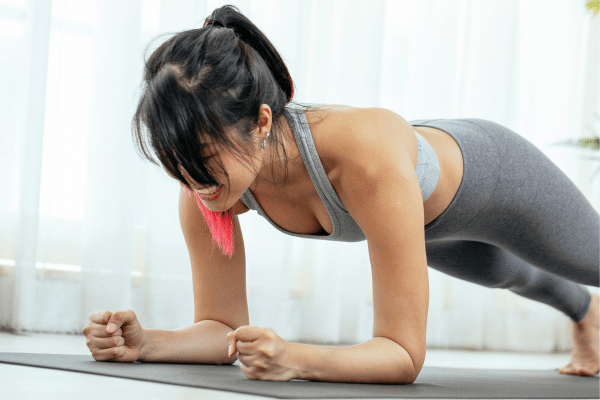Core strength is a fundamental aspect of overall health and fitness, essential not just for athletes but for everyone. It’s the bedrock that supports a range of physical activities, from everyday tasks to high-performance sports. This blog post explores various techniques to enhance core strength, including exercises, dietary tips, and lifestyle adjustments. It aims to provide a comprehensive guide for improving core stability and endurance, thereby enhancing quality of life and reducing the risk of injury.
Contents
Understanding Core Strength

Core strength refers to the robustness of muscles in the abdomen, back, and pelvis, crucial for stability and balance. These muscles play a pivotal role in almost every movement, from lifting groceries to running marathons. Strengthening the core not only improves posture and athletic performance but also helps prevent back pain and injuries. While many believe core strength is all about having a toned abdomen, it actually involves a much broader spectrum of muscles working in harmony.
Misconceptions about core training are widespread. Many assume that endless crunches are the key to a stronger core. However, core strength is not just about sculptural abs; it’s about functional fitness. A well-rounded core workout targets various muscle groups, ensuring balanced development. Overemphasis on a single type of exercise can lead to imbalances and potential injuries. Understanding this complexity is crucial for effective core training.
The Role Of Diet In Core Strength

Nutrition plays a critical role in building and maintaining core strength. Muscles need the right fuel to grow and recover from workouts. A diet rich in proteins, healthy fats, and complex carbohydrates provides the necessary energy and building blocks for muscle development. Protein-rich foods like lean meats, beans, and dairy are particularly important for muscle repair and growth.
Equally important is staying hydrated and avoiding excessive intake of processed foods and sugars, which can lead to inflammation and weight gain, counteracting core strengthening efforts. Including a variety of fruits, vegetables, and whole grains ensures a supply of essential vitamins and minerals, supporting overall health and fitness. Tailoring dietary habits to complement core training can significantly enhance the effectiveness of the workouts.
Beginner Core Exercises

For beginners, starting with basic exercises is key to building a solid foundation. Planks, for example, are a great way to engage the entire core without needing any equipment. They can be modified to suit different fitness levels and are effective in enhancing stability and endurance. Another fundamental exercise is the bridge, which strengthens the lower back and abdominal muscles, crucial for improving posture and reducing the risk of back pain.
In addition to planks and bridges, incorporating leg lifts and seated twists into a routine can help target different areas of the core. It’s important to focus on form and controlled movements rather than the number of repetitions. Beginners should also remember to breathe correctly during these exercises, as proper breathing aids in engaging core muscles more effectively and ensures safety.
Advanced Core Workouts

For those with a stronger fitness base, advanced core workouts can offer the challenge needed for further strengthening. Exercises like Russian twists, hanging leg raises, and stability ball exercises engage the core muscles in a more intense manner. These workouts not only improve core strength but also enhance coordination and balance.
Incorporating equipment like medicine balls and resistance bands can add variety and increase the intensity of core workouts. It’s important for individuals to listen to their bodies and progress at a pace that feels challenging yet safe. Advanced exercises should be performed with a focus on maintaining proper form to maximize benefits and minimize the risk of injury.
Incorporating Core Strength Into Daily Life

Core strength is not just about the exercises performed in the gym; it can also be integrated into daily activities. For instance, maintaining good posture while sitting or standing engages the core muscles, helping to strengthen them over time. Simple activities like walking, taking the stairs, or even gardening can become opportunities to engage the core with slight modifications in body mechanics.
Understanding and applying the principles of core engagement in everyday life can have a significant impact. For example, lifting objects using the legs and keeping the core engaged can prevent back strain. This constant, low-intensity engagement of core muscles complements more structured workouts and contributes to overall core strength and stability.
The Mind-Body Connection

The connection between mental health and physical fitness is vital, especially in developing core strength. Stress and anxiety can lead to muscle tension, particularly in the core area, hindering progress in strengthening these muscles. Engaging in relaxation techniques like deep breathing, yoga, or meditation can help alleviate stress, allowing for more effective core training.
Additionally, being mentally present and focused during core workouts enhances the mind-body connection. This mindfulness ensures better engagement of the correct muscle groups and leads to more effective workouts. Understanding and harnessing this connection can be a powerful tool in achieving core strength goals.
Common Pitfalls And How To Avoid Them

One common pitfall in core training is focusing solely on abdominal exercises while neglecting other core muscles. This unbalanced approach can lead to muscle imbalances and potential injuries. To avoid this, a comprehensive core workout should include exercises targeting all areas of the core, including the back and obliques.
Another frequent mistake is prioritizing quantity over quality. Performing a large number of repetitions with poor form is less effective and more risky than doing fewer repetitions correctly. It’s essential to focus on proper technique and to gradually increase the intensity of the workouts. Staying informed and possibly seeking guidance from fitness professionals can help in avoiding these common mistakes.
The Bottom Line
In conclusion, improving core strength is a multifaceted endeavor that goes beyond basic exercises. It involves a combination of proper training, balanced nutrition, integration of core activities into daily life, and a strong mind-body connection. Tailoring a core strength routine to individual needs and progressing at a sustainable pace are key to achieving lasting results. With dedication and a holistic approach, enhancing core strength can lead to significant improvements in health, fitness, and overall well-being.


